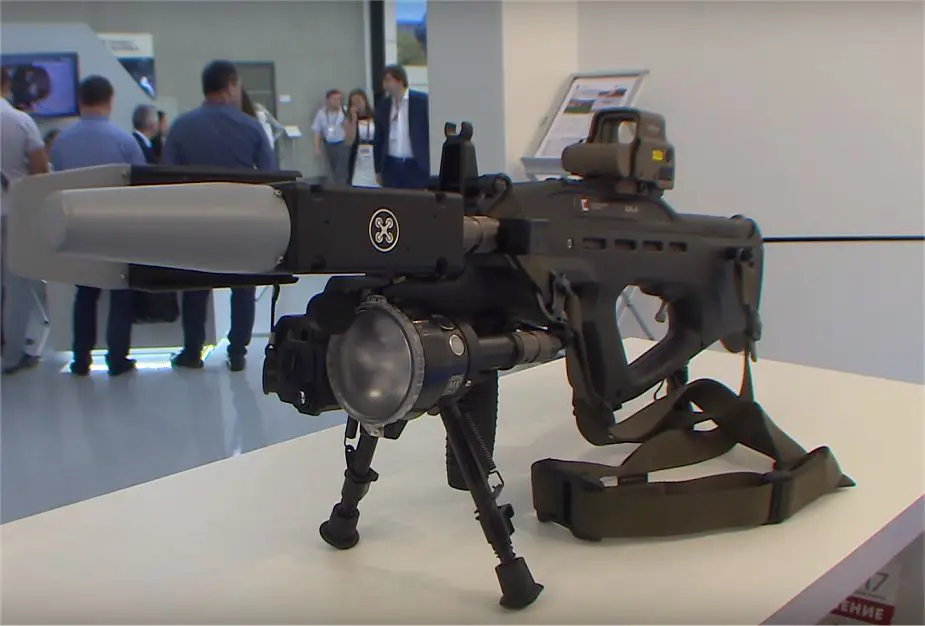Russian soldiers will receive electronic warfare REX-1 gun to fight drones
New electronic warfare (EW) REX-1 gun is supplied to the Russian troops in the framework of the defense procurement order. The Zvezda weekly analyzed the new EW devices to fight drones.

Russian-made Electronic warfare (EW) REX-1 gun. (Picture source Print Screen RT Footage)
Silok complex belongs to modern EW designs. It automatically detects drones, determines their coordinates and jams the vehicles in various frequency bands. The device breaks down control, telemetric and communications channels and the drone becomes metal scrap. Open sources said Silok can jam drones at a distance of four kilometers from the deployment base. It was designed by Sozvesdie defense concern.
Russian ZALA AERO Company of Kalashnikov Concern is a leading producer of unmanned aerial vehicles (UAV) and means of their engagement. The company presented an original EW REX-1 gun to fight drones.
The electromagnetic device destroys any UAV, including multicopters, over water and ground at direct visibility distance. REX-1 was tested at the large-scale Vostok-2018 maneuvers.
It has a jamming unit to suppress US GPS navigational signals, the Russian GLONASS, the Chinese BeiDou and European Galileo in a radius of five kilometers. It can block GSM, 3G, LTE signals at a distance of five kilometers and jam them in various bands. REX-1 makes a drone malfunction, but does not damage it physically. The UAV loses communications with the operator and softly lands. The gun has fixtures to mount sights, searchlights, aimers and control means. REX-1 weighs 4.2 kg. It has an inbuilt power source for 3-hour uninterrupted operation.
The line of EW products by ZALA AERO was continued by antidrone ZALA ZONT. It jams satellite navigation signals (GPS, GLONASS, BeiDou, GALILEO) in a 2-km radius to prevent a drone attack on ground forces. ZONT prevents precise determination of coordinates to provide stealth movement.

Russian weapons manufacturer Kalashnikov demonstrated its REX-1 anti-drone gun at the International Military-Technical Forum Army 2017 near Moscow, Russia. (Picture source Print Screen RT footage)
Its advantages comprise small weight (800 grams) and size. The battery (150x90x40mm) and the jammer (180x90x30) make it possible to carry the device in a standard bag for a submachine magazine. ZALA ZONT operates for six hours and can be powered or recharged by an ordinary electric network of 110 or 220 V. Designers said the new electronic security device can effectively operate at temperatures of -40 to +50 degrees Centigrade.
Roselectronika Holding designed Cheremukha monitoring module to detect drones and determine their remote control places. It will become a part of a single antidrone weapon.
The new device confirmed its effectiveness. It determines the direction of drones and operator with a two-degree error. Cheremukha will be integrated into the single antidrone weapon which will also have a passive coherent radar and the SERP EW module. It is created by Vektor Institute of Roselectronika.
The passive coherent radar detects all objects which reflect radio waves. Cheremukha, in its turn, determines whether the exposed targets receive radio signals, whether they are drones, and finds control posts. It provides coordinates for artillery fire or precision weapon strike.
The complex will have two options - stationary and mobile. The choice of the modification, the necessary number of modules and their distribution on the territory of the guarded facility, as well as the zone of responsibility for each module will be determined according to customer requirements, the configuration of the facility and potential threats.
Sozvezdie designed the latest smart system to protect a territory from drone penetration. The first Russian automatic EW complex to fight drones can ensure defense from automatic air reconnaissance and attack means on a space of 80 square kilometers. The EW complex operates automatically without an operator. It detects a flying object, analyzes the trajectory and signal structure, determines whether the craft is friend or foe and decides on the necessary action. After the object is identified as an adversary drone, the complex jams it, blocks data transmission channels and navigational equipment. The drone loses orientation and falls. Solaris-N complex is built by a modular scheme which helps optimize its composition depending on conditions on the battlefield.
The engagement of Russian EW troops is predicted to grow in various strategic directions 2-2.5-fold by 2020. The Defense Ministry said EW troops received over 600 new-generation weapons in five years. The share of modern hardware reached 67 percent. The military command plans to up the share of modern EW weapons to 70 percent by 2021, the Zvezda weekly said.


























